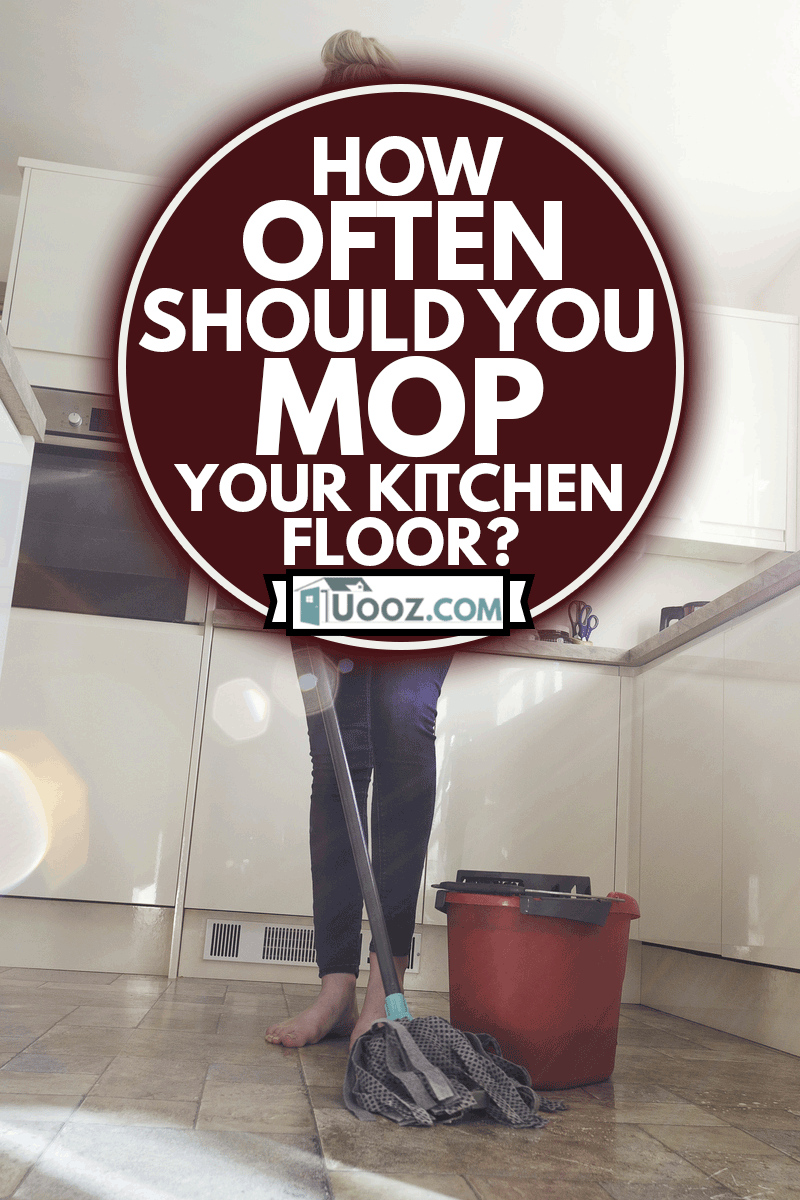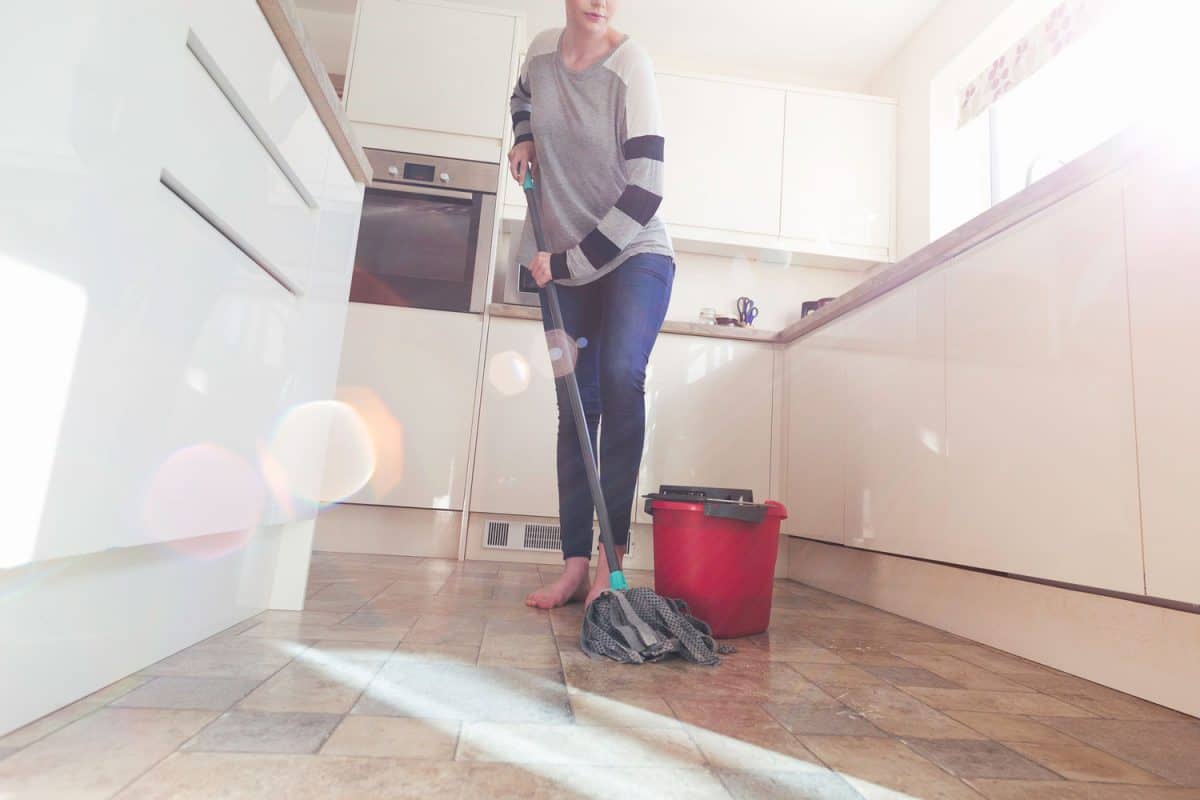The kitchen is one of the most heavily used areas of the home. The use involves foot traffic, wet dishes, messy recipes, and ingredient clean-up. No matter how clean you mean to keep it, the kitchen floor gets dirty. So you are wondering, how often should you mop the kitchen floor? In this post, we thoroughly answer your question by gathering up-to-date research.
Generally, you should wet-mop your kitchen floor between once a week and twice a month. The details of how to mop and precisely how frequently you need to mop depend on the type of flooring. Flooring types include laminate, tile, linoleum, and hardwood.
Keep reading the rest of this post for more details on how to mop your kitchen floors by floor type. We include all you need to know to ensure a clean, hygienic, and long-lasting kitchen floor. In addition, we answer a few questions related to the topic of this post.

Why is it Important to Mop Your Kitchen Floor?
First of all, mopping your kitchen floors improves house cleanliness and hygiene - advantages that almost go without saying. However, routine wet mopping of kitchen floors also confers other less obvious benefits to you and your home.
Click here to see this mop and bucket kit from Amazon.
The first of these advantages is a reduction in allergens. That is to say, pet dander, dust, and pollen collect on your floors and can cause allergic reactions. Regular mopping prevents this accumulation. The second less obvious advantage of regular mopping is an increase in flooring longevity. Essentially, dirt, dust, and grime scatch and damage uncleaned floors.
How Often to Mop your Kitchen Floor
The general recommendation is to mop your floor every two weeks. However, if you use your kitchen irregularly or perhaps sweep your kitchen very often - it might not be necessary to mop quite so frequently. Further, different flooring types require different mopping techniques. The differences based on flooring types are covered in the following sections.
Laminate Flooring
Laminate is a modern, affordable, and popular kitchen flooring material. While durable, laminate flooring does require specific care in order to maximize the flooring lifespan.
How often should you mop laminate floors?
Laminate floors require less frequent mopping than many other kitchen flooring types. In fact, sources recommend mopping laminate floors every two weeks to one month. This schedule requires that you do clean up spills immediately. It is inadvisable to mop laminate flooring more frequently because laminate is sensitive to water.
How to Mop Laminate Floors
The most important factor to consider when mopping laminate floors is to use cleaning solutions and techniques which satisfy the recommendations of the flooring manufacture. Generally, these recommendations are to use cleaners that are not particularly strong and mops that are soft and non-abrasive. Check with the recommendations provided with your flooring or from the flooring company.
Click here for a laminate cleaner from Amazon.
Usually, all you need to do is lightly mop the flooring with a water-vinegar mix. Do not overwet the floor because the water can get behind the flooring and causing warping and other issues. For the best finish, dry the flooring with some sort of microfiber after mopping.
Wood Flooring
Hardwood flooring is a common kitchen flooring type. Of the flooring discussed here, hardwood is one of the most sensitive to grime and an improper cleaning schedule. For more information on hardwood floors, read this article: Should Hardwood Floors Match Throughout The House?
Should hardwood floors be mopped?
Since wood is a material that is obviously sensitive to water, many wonder if hardwood floors should be mopped. The answer is yes. However, as this type of flooring is sensitive to water and many cleaners, care is required if you do not want to warp or discolor the hardwood.
How often should you mop wood floors?
You should dry mop and sweep your wood kitchen floors weekly. In addition to cleaning any spilled liquid, these simple tasks will keep your hardwood quite clean. In terms of wet mopping, it is recommended that you only need to deep clean wet mop two to five times per year. Mop more frequently for dirtier kitchen floors. Be careful not to over-mop because wood is sensitive to water.
How to mop wood floors
To mop hardwood floors, use a hardwood-specific cleaning material that you dilute according to the instructions on the container.
Click here for hardwood floor cleaner from Amazon.
Dip the mop in this solution and wring most of the water out so it only feels slightly damp. As you mop the floor, regularly refresh the mop from the bucket and make sure to avoid creating any standing water. Dry the floor with a fresh mop or towel after completion.
Tile Floors
Tile flooring is durable and easy to clean. While expensive, the least specific care is required when mopping and cleaning your tile floors. For more reading on great tile floors read this article: 6 Best Types Of Tiles For Kitchen Floors.
How often should you mop tile floors?
Depending on how dirty your floors are getting, it is appropriate to mop your tile floors about every two weeks. For best results, be sure to also sweep and clean up any spills as soon as possible. In addition, your floors will maintain their shine much longer if you also clean your grout every two months or so.
How to mop tile floors
For tile, it is appropriate to use almost any household cleaner or soap. Common options include dish soap and mild detergent. Also, be sure to use a chamois mop rather than a sponge mop. The tighter connection a sponge mop makes with the floor causes it to push all the water into the grout lines. A chamois mop does a better job of evenly distributing the water and cleaner.
Click here for a chamois mop head from Amazon.
Once you have mopped your tile floor, take the time to dry with a towel or dry mop. If left to dry alone, water will create water spots on the tile which are nearly impossible to remove.
How to clean tile grout
Cleaning tile grout is simple but relatively labor-intensive. An appropriate cleaner can be made using baking soda and water, mixed until you have a paste the consistency of toothpaste. Using a brush with softer bristles, scrub the grout lines. Rinse with water and dry with a soft towel.
Linoleum Floors
Linoleum offers an affordable and easily replaceable alternative to some of the other kitchen floor materials discussed in this post. Like tile, linoleum is not overly sensitive to soaps or water so it can be mopped much more often and with less care.
How often should you mop linoleum floors?
Mop linoleum floors every two weeks or as needed. Unlike laminate and wood, linoleum is not sensitive to water. In addition to mopping, it is smart to regularly sweep and clean spills.
How to mop linoleum floors
Wet mop your linoleum floor with any type of mop and any general-purpose cleaner or light detergent. Try not to let water pool on the floor and do not forget to refresh the water and cleaner in the mop regularly. For the best result, and as always, dry the floor after mopping.
What is the best way to clean a kitchen floor?

The best way to clean a kitchen floor depends on the floor type. A general guideline is to clean up any spills as soon as they are made, to sweep or dry mop daily, and then to mop according to the schedule and techniques described above.
What is the most hygienic mop?
The current standard for the most hygienic mop is those made out of microfiber. These mops dry quickly and are soft on your flooring. The quick-drying nature makes them more hygienic than many traditional mops. Other hygienic mops include ones with replaceable heads and ones with washable heads.
Click here for a microfiber mop from Amazon.
What is the best floor mop to buy?
The best floor mop to buy is one that you can afford and will use. Do not purchase the nicest mop money can buy if you do not have an appropriate storage area or need for it. Generally, chamois type mops, the ones with a bunch of soft strings, with an accompanying bucket are versatile and make excellent wet mop purchases.
In Closing
As a basic rule of thumb, you should wet-mop your kitchen floors every week to every other week. Remember to clean up spills immediately and then dry off your wet-mopped floors if it's prone to warping or water damage.





